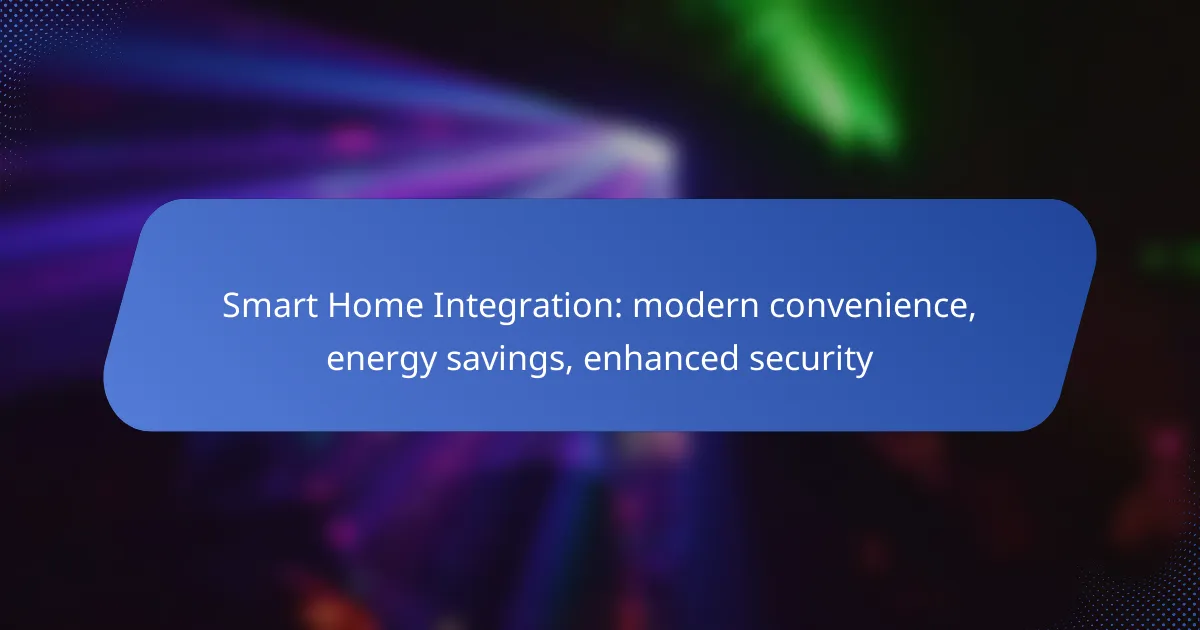Smart home integration revolutionizes modern living by offering unparalleled convenience, energy efficiency, and enhanced security. By automating everyday tasks and allowing remote control of devices, homeowners can streamline their routines while optimizing energy consumption and reducing costs. Additionally, interconnected security systems provide real-time monitoring and alerts, ensuring peace of mind and protection against potential threats.
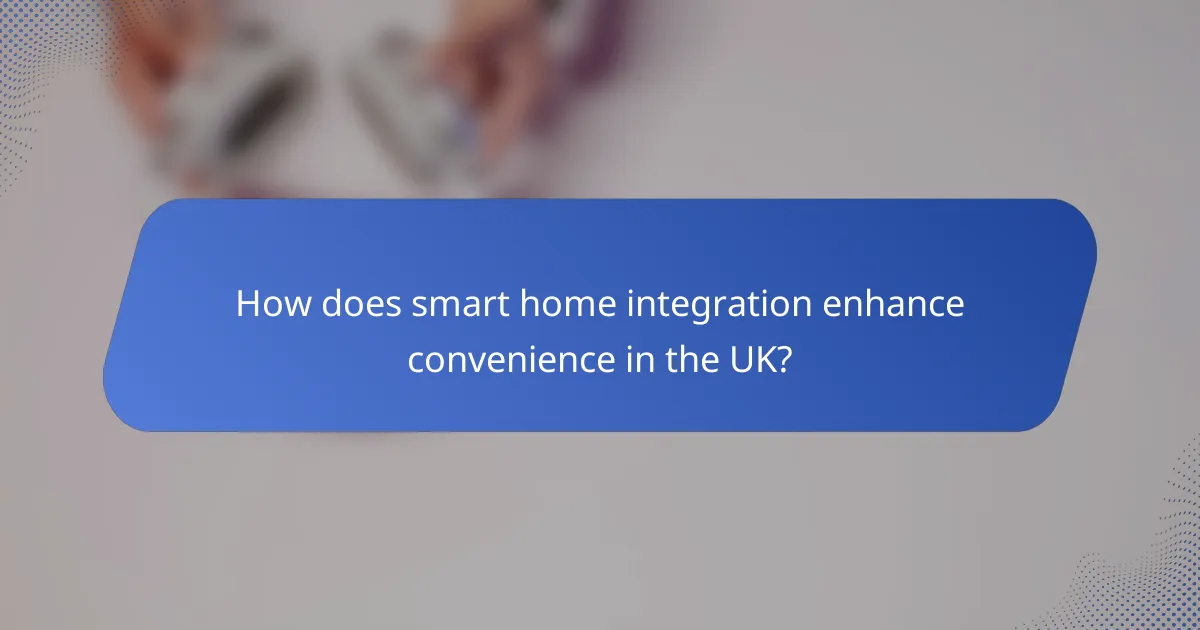
How does smart home integration enhance convenience in the UK?
Smart home integration enhances convenience in the UK by automating everyday tasks, allowing users to control various devices remotely, and streamlining home management. This technology simplifies daily routines, making it easier to manage energy use and security from a single interface.
Automated lighting systems
Automated lighting systems allow homeowners to control lights based on schedules, occupancy, or even natural light levels. For instance, lights can automatically turn on at sunset or when someone enters a room, which not only enhances convenience but also improves energy efficiency.
Many systems are compatible with mobile apps, enabling users to adjust lighting from anywhere. This feature is particularly useful for ensuring that lights are off when leaving home, reducing energy waste and lowering electricity bills.
Smart thermostats like Nest
Smart thermostats, such as Nest, learn user preferences and adjust heating and cooling accordingly, providing both comfort and energy savings. They can be programmed to lower temperatures when the house is empty or during the night, optimizing energy use without sacrificing comfort.
In the UK, these devices can help homeowners save on heating bills, especially during colder months. Users can monitor and control their thermostat remotely, ensuring their home is at the desired temperature upon arrival.
Voice-controlled assistants such as Amazon Alexa
Voice-controlled assistants like Amazon Alexa enhance convenience by allowing users to manage smart home devices through voice commands. This hands-free operation is particularly beneficial when multitasking or when hands are occupied.
These assistants can control lighting, adjust thermostats, and even provide reminders or play music, making daily life more manageable. Integration with various smart devices ensures a cohesive smart home experience, streamlining interactions and improving overall efficiency.
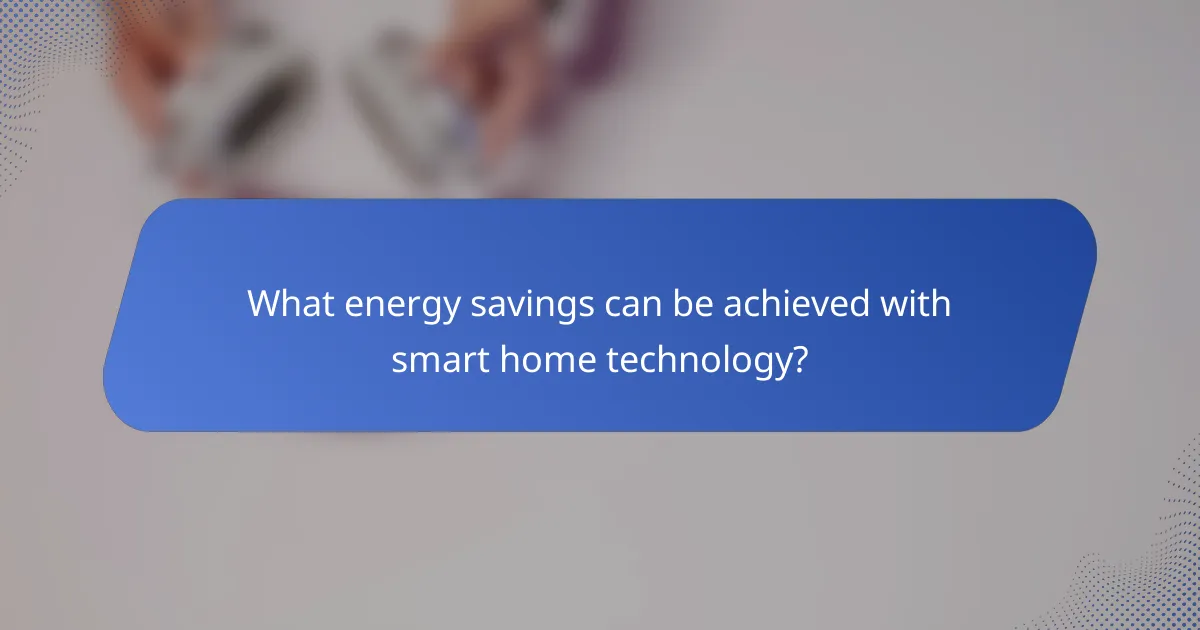
What energy savings can be achieved with smart home technology?
Smart home technology can lead to significant energy savings by optimizing energy consumption and reducing waste. By integrating various smart devices, homeowners can lower their utility bills while contributing to environmental sustainability.
Energy-efficient appliances
Energy-efficient appliances are designed to use less energy while performing the same tasks as standard models. These appliances often carry Energy Star ratings, indicating they meet strict energy efficiency guidelines set by the U.S. Environmental Protection Agency.
For example, a smart refrigerator can monitor its energy usage and adjust settings based on usage patterns, potentially saving 10-50% on energy costs compared to older models. When upgrading, consider appliances that offer smart features like remote monitoring and control.
Smart energy monitoring systems
Smart energy monitoring systems provide real-time data on energy consumption, helping homeowners identify patterns and areas for improvement. These systems can track usage by appliance, allowing for targeted energy-saving strategies.
Many systems offer mobile apps that send alerts about unusual energy spikes, enabling quick responses to potential issues. By using these insights, homeowners can reduce energy waste and save on monthly bills, often achieving savings of 5-15% in energy costs.
Programmable heating and cooling
Programmable heating and cooling systems allow homeowners to set schedules for when their HVAC systems operate, optimizing energy use. By adjusting temperatures based on occupancy, these systems can significantly reduce energy consumption.
For instance, setting the thermostat to lower temperatures during the night or when no one is home can lead to savings of 10-20% on heating and cooling costs. It’s advisable to invest in smart thermostats that learn user preferences and automatically adjust settings for maximum efficiency.
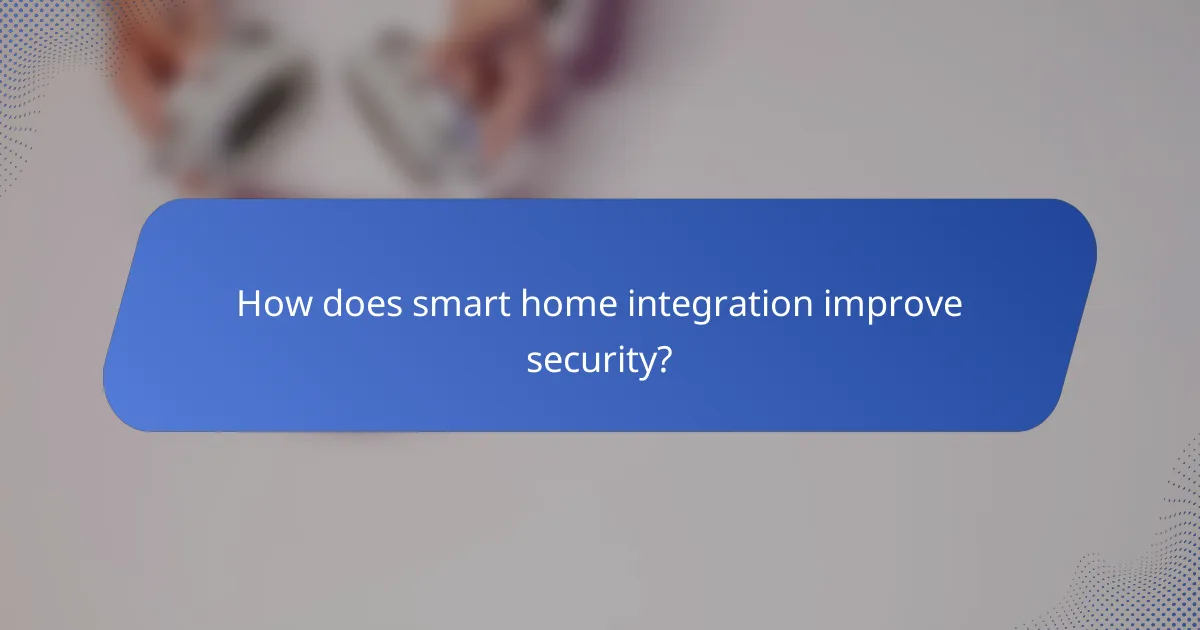
How does smart home integration improve security?
Smart home integration enhances security by utilizing interconnected devices that monitor and protect your home. These systems provide real-time alerts, remote access, and automation to help prevent unauthorized entry and respond quickly to potential threats.
Smart security cameras like Ring
Smart security cameras, such as Ring, allow homeowners to monitor their property remotely through smartphone apps. These cameras often feature motion detection, night vision, and two-way audio, enabling users to communicate with visitors or potential intruders.
When selecting a smart camera, consider factors like video resolution, storage options, and integration with other smart home devices. Many models offer cloud storage plans, which can range from free to a monthly fee depending on the features and duration of video retention.
Automated door locks
Automated door locks provide enhanced security by allowing you to lock and unlock doors remotely. These locks can be controlled via smartphone apps and often include features like temporary access codes for guests or service providers.
When choosing an automated door lock, look for options that offer compatibility with your existing smart home system and consider battery life and security features, such as encryption and tamper alerts. Many models are designed to fit standard door hardware, making installation straightforward.
Home alarm systems with mobile alerts
Home alarm systems equipped with mobile alerts notify homeowners of security breaches in real time. These systems can include door and window sensors, motion detectors, and sirens, all of which can be monitored and controlled through a mobile app.
When selecting a home alarm system, consider whether it offers professional monitoring services or if you prefer a self-monitored option. Look for systems that allow for easy integration with other smart devices and provide customizable alert settings to suit your preferences.
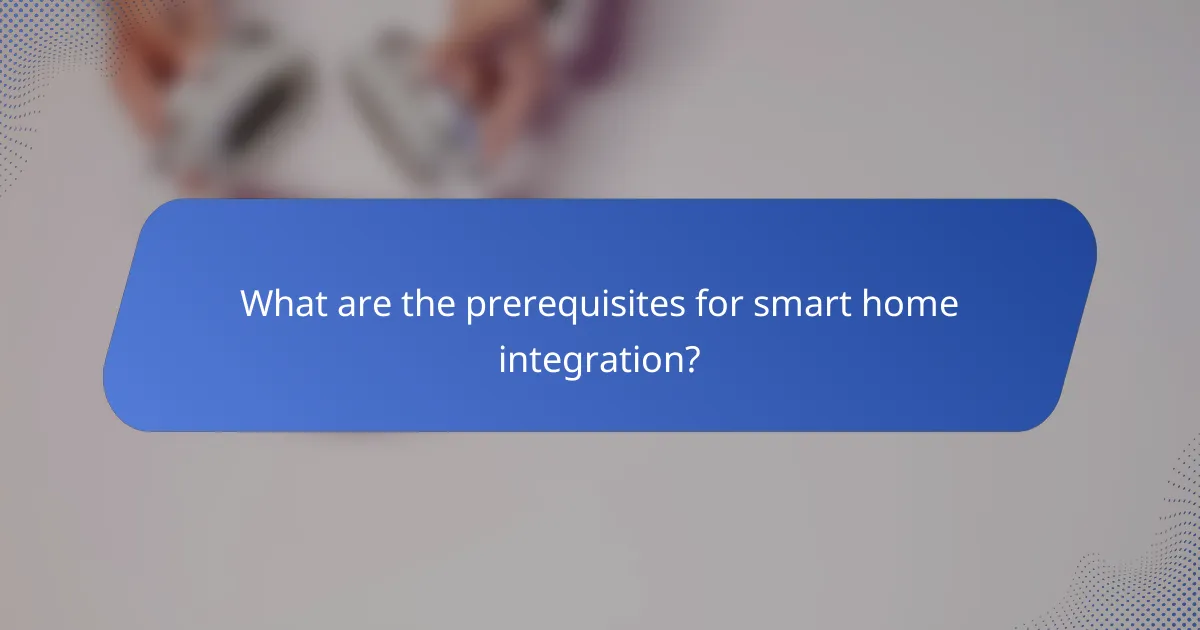
What are the prerequisites for smart home integration?
To successfully integrate smart home technology, you need a reliable Wi-Fi network and compatible smart devices. These elements form the foundation for seamless communication and functionality within your smart home ecosystem.
Reliable Wi-Fi network
A dependable Wi-Fi network is crucial for smart home integration, as it enables devices to communicate effectively. Aim for a network with a speed of at least 25 Mbps for optimal performance, especially if multiple devices are connected simultaneously.
Consider the layout of your home when setting up your Wi-Fi. Dead zones can hinder device connectivity, so using Wi-Fi extenders or a mesh network can help ensure coverage throughout your space. Regularly check your network’s performance to avoid interruptions.
Compatible smart devices
Choosing compatible smart devices is essential for a cohesive smart home experience. Look for devices that support common standards such as Zigbee, Z-Wave, or Wi-Fi, which facilitate integration with your central hub or app.
Before purchasing, verify that the devices you select can work together. Many manufacturers provide lists of compatible products, making it easier to build a unified system. Avoid mixing brands that do not support interoperability to prevent functionality issues.
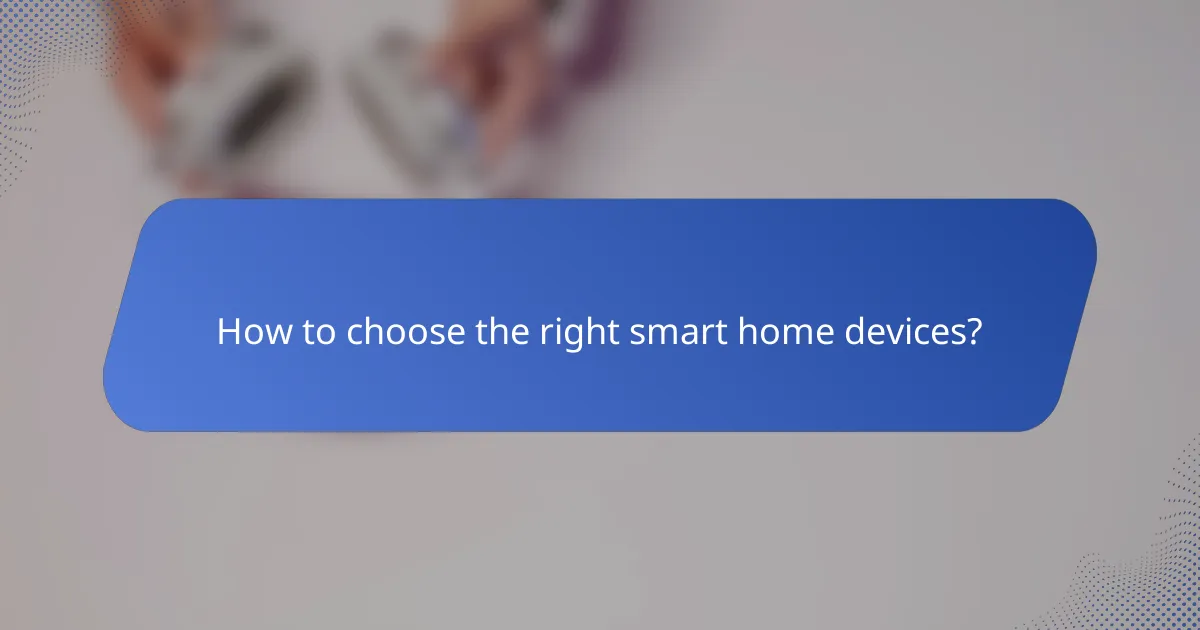
How to choose the right smart home devices?
Choosing the right smart home devices involves assessing compatibility, user feedback, and energy efficiency. Prioritize devices that seamlessly integrate with your existing systems and have positive reviews to ensure a satisfactory experience.
Consider compatibility with existing systems
Before purchasing smart home devices, check their compatibility with your current systems, such as smart hubs or voice assistants. Devices from the same ecosystem, like Google Home or Amazon Alexa, often work better together, providing a smoother user experience.
For example, if you already use Philips Hue lights, consider adding other Philips smart devices to maintain compatibility. This can simplify setup and enhance functionality, allowing for easier control and automation.
Evaluate user reviews and ratings
User reviews and ratings are invaluable resources when selecting smart home devices. Look for products with high ratings and read through user experiences to identify potential issues or advantages.
Focus on reviews that mention ease of installation, reliability, and customer support. Devices with a significant number of positive reviews are generally more trustworthy and likely to meet your expectations.
Assess energy efficiency ratings
Energy efficiency ratings are crucial for selecting smart home devices that can help reduce your utility bills. Look for products labeled with Energy Star or similar certifications, which indicate they meet energy-saving standards.
For instance, smart thermostats can significantly lower heating and cooling costs by optimizing usage based on your habits. Devices that consume less energy not only save money but also contribute to a more sustainable home environment.






